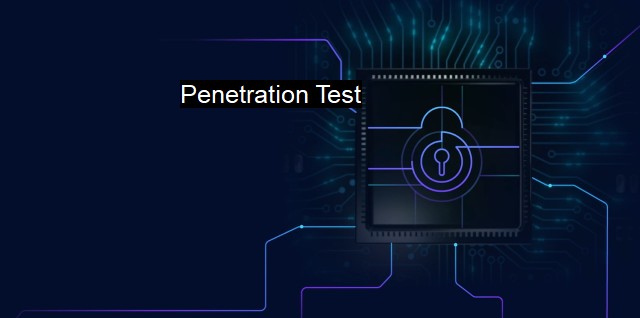What is Penetration Test?
Exploring Cybersecurity Threats: Understanding the Importance and Process of Penetration Testing
A penetration test, commonly known as a pen test or ethical hacking, is a simulated cyber-attack against your computer system designed to check for exploitable vulnerabilities. it is an indispensable way of strengthening the computer system or network security by identifying breaches that may exist in those systems due to improper system configuration, known or unknown software or hardware flaws, or even operational weaknesses in functions or technical countermeasures.Penetration tests are categorized into two; black box penetration testing and white box penetration testing. In the black box testing, the ethical hacker doesn't have any specific information about the system, hence tests are performed from the perspective of a real attacker. Conversely, white box testing allows the attacker to have full knowledge about the system, including source code, IP address, network protocols, and even the schemes used. These categories differ based on the level of knowledge of the system the attacker has and the kind of test that will be perform. Another classification regards the scope of the test, either being a targeted test, where both the IT team and attacker work together, or an external or internal test, depending on the source of the attack.
The reason why penetration testing is crucial in the context of antivirus is because just using an antivirus is not enough to secure systems from malicious attacks. Antiviruses work by identifying malicious software through signature databases that constantly get updated. But the relatively newer and hence potentially unidentified cyber threats might easily bypass this security check, leaving the systems vulnerable to attacks. A penetration test takes this security check to a higher level by simulating attacks and investigating how the system responds, and as a result, better safeguards the system.
Penetration testing is a 'controlled form of hacking' in which a professional pentester works to identify potential vulnerabilities in a system then exploits them, but with permission and safety controls. The ultimate objective here is not to disrupt the network or create real havoc but to probe, identify, and escalate system weaknesses that real attackers could exploit. By understanding the vulnerabilities, organizations can strategically patch these shortcomings and ensure that they have tight security controls to severely reduce the chances of actual breach.
It is a comprehensive assurance activity since it assesses systems from all points of view, internal and external, by engineers and automated systems, considering malicious and innocent intent. The results give a holistic view of points to amend and fundamentally improve security by detailing technical vulnerabilities, providing understanding of how any breach might occur, what potential costs and impacts might result from the breach, and how to address the vulnerabilities. There will always be a next determined intruder with more sophisticated hacking tools. As such, regular penetration tests should be performed maybe annually or even more frequently depending on the organization or importance of the data to thwart such future threats.
Both penetration testing and antivirus are key elements in the cybersecurity realm in an age marked by increasing digital threats and advancements in hacking techniques. As preventive cybersecurity measures, they help organizations keep their internal IT infrastructures secure. While the antivirus provides defense against recognized malware and unwanted intrusion attempts, penetration testing offers an incisive approach to discover system vulnerabilities and helps to provide an extra thick security wall.
Cyber threats are a daily and increasing concern for organizations and individuals alike, and these need meticulous addressing as technological advancements continue. The comprehensive antidote lies in punctilious practice like penetration testing which fortifies the already existing defensive measures such as antiviruses. It’s a continuous process involving identifying, testing and improving the organization's security structure to stay ahead of the continuous incoming threats.

Penetration Test FAQs
What is a penetration test?
A penetration test is a simulated cyberattack on a computer system, network or web application to identify vulnerabilities and potential security breaches. It is performed to evaluate the effectiveness of the existing security infrastructure and to provide recommendations for improvement.Is a penetration test important for cybersecurity?
Yes, a penetration test is an essential tool for cybersecurity. It helps to identify and mitigate potential security risks, improve the security posture of an organization, and ensure compliance with regulatory requirements. By performing regular penetration tests, organizations can stay ahead of potential threats and prevent costly security breaches.What are the benefits of a penetration test?
A penetration test provides several benefits, including identifying potential security vulnerabilities, providing recommendations for improvement, testing the effectiveness of existing security controls, improving the overall security posture, and meeting regulatory compliance requirements. It also helps to prevent reputational damage and financial losses that can result from a security breach.How often should a penetration test be performed?
The frequency of penetration testing depends on several factors, including the size of the organization, the complexity of the IT infrastructure, the level of security required, and regulatory compliance requirements. Generally, it is recommended to perform penetration testing annually, or after any major changes to the IT environment, such as system upgrades or new software installations.| | A | | | B | | | C | | | D | | | E | | | F | | | G | | | H | | | I | | | J | | | K | | | L | | | M | |
| | N | | | O | | | P | | | Q | | | R | | | S | | | T | | | U | | | V | | | W | | | X | | | Y | | | Z | |
| | 1 | | | 2 | | | 3 | | | 4 | | | 7 | | | 8 | | |||||||